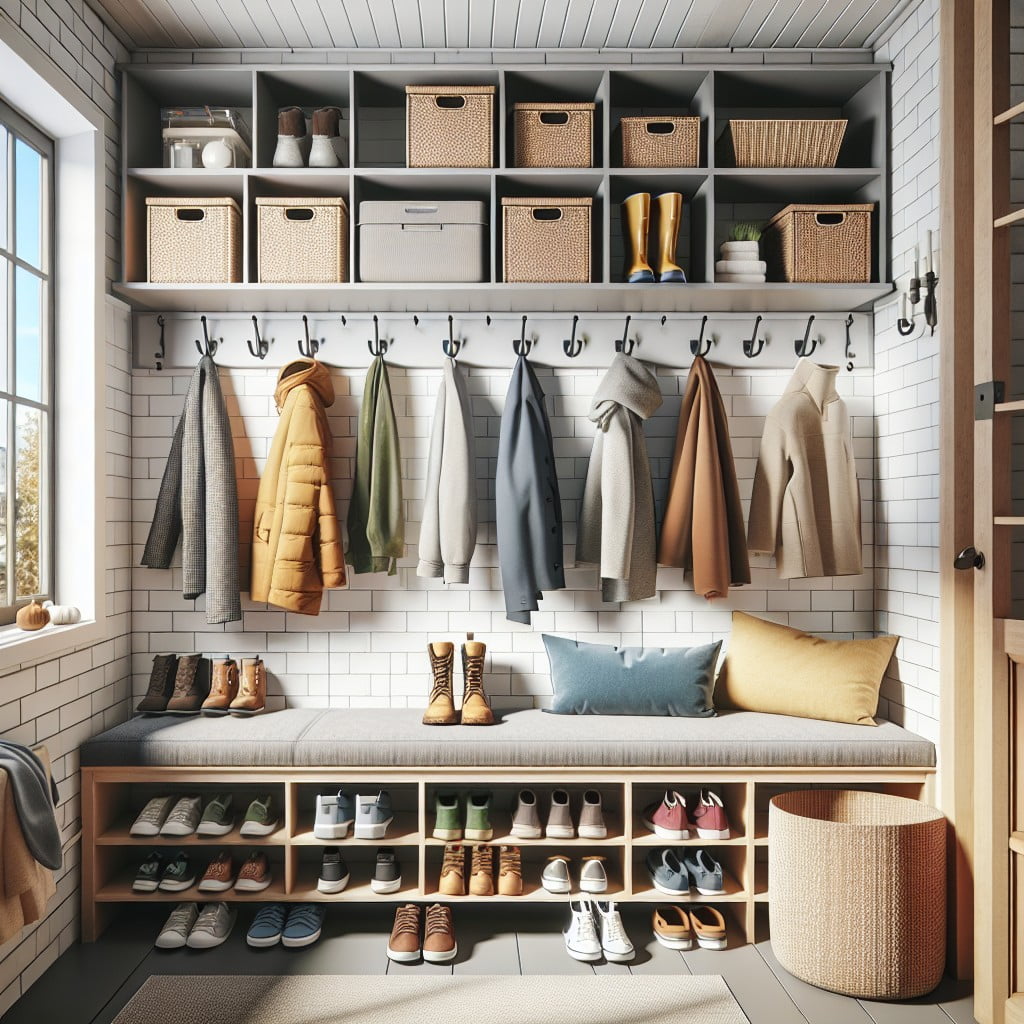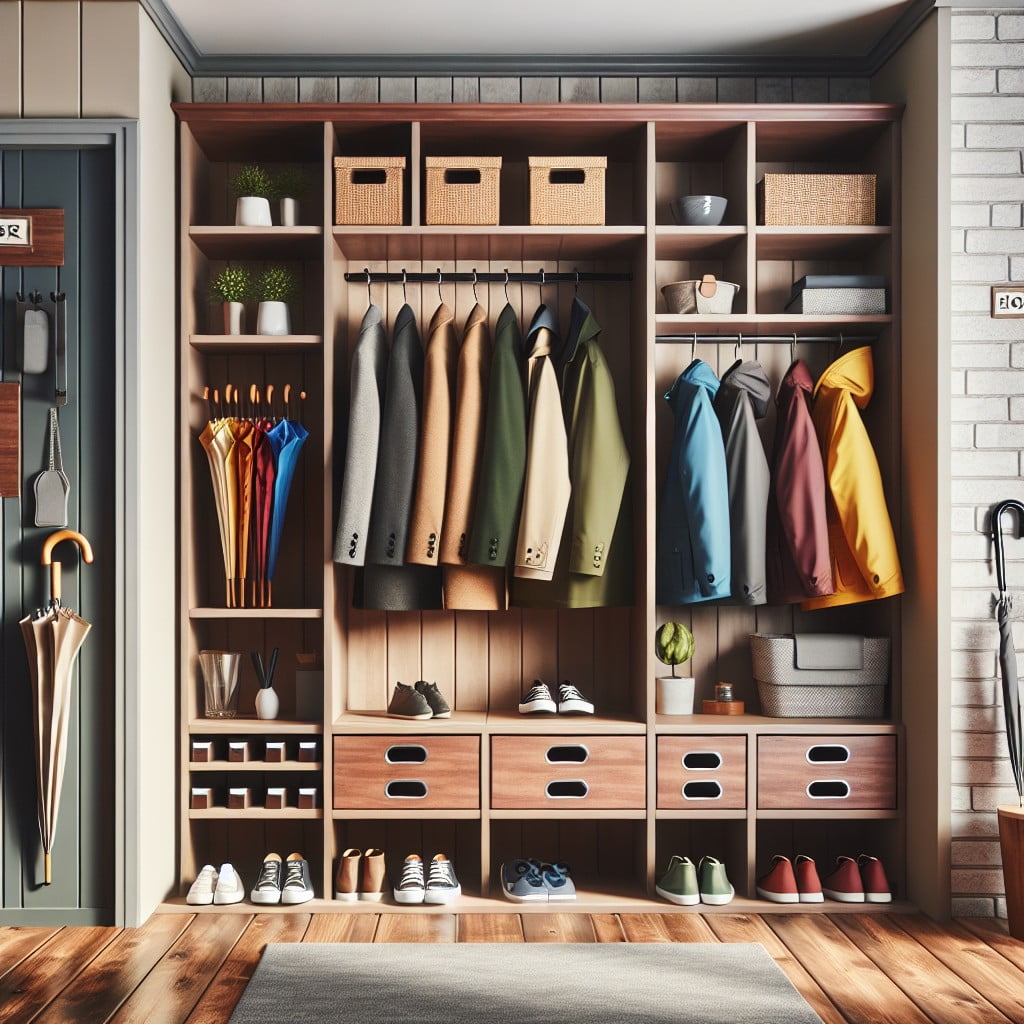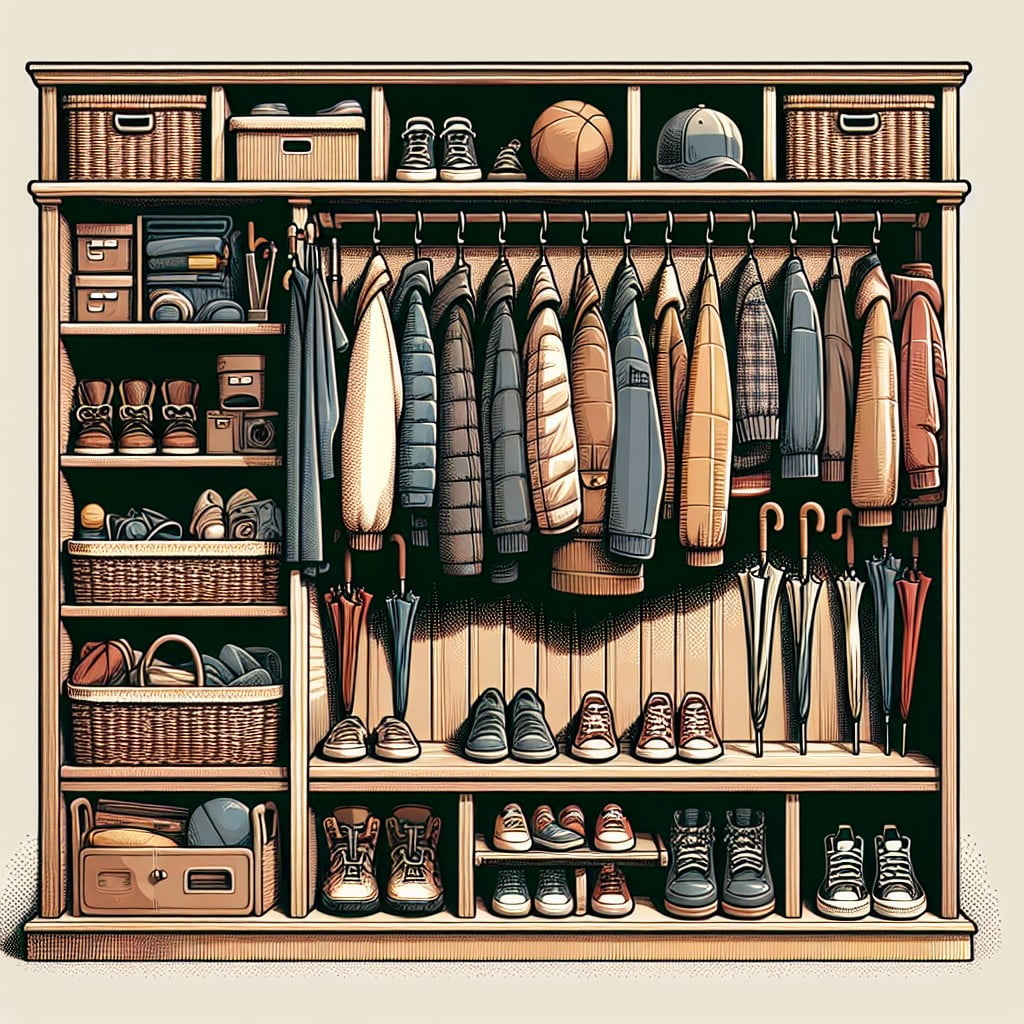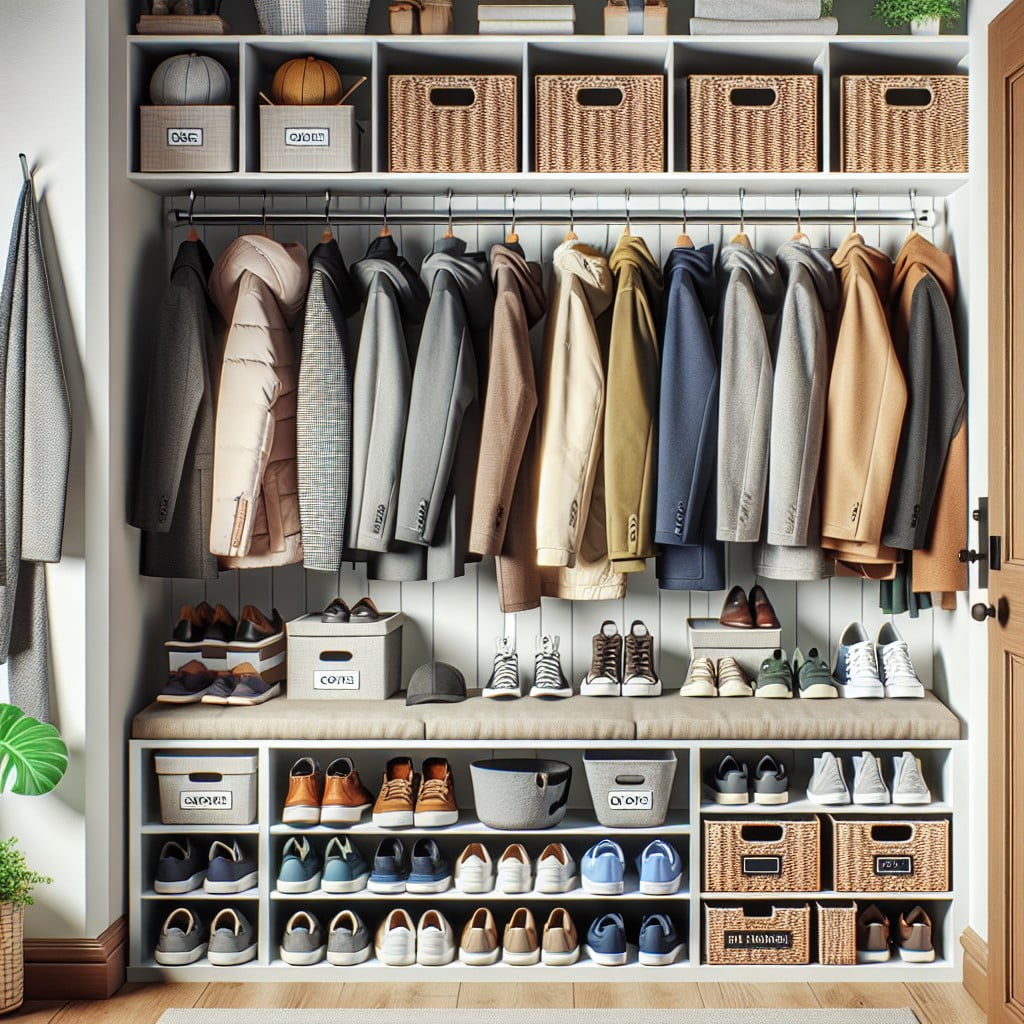Last updated on
Mastering the art of mudroom closet organization is easier than it may initially seem because it unlocks underused storage potential, making your daily routines more efficient and orderly.
Key takeaways:
- Assess your mudroom space: Consider measurements, flow of traffic, and existing features.
- Define primary functions: Determine the main purposes of your mudroom.
- Evaluate storage needs: Take inventory and consider vertical storage options.
- Sort and declutter items: Categorize and evaluate each item’s frequency of use.
- Incorporate closed storage: Use upper and lower cabinets for organization.
Assess Your Mudroom Space

When evaluating your mudroom, start by taking precise measurements of the area to understand the available space. Consider any windows or doors that might dictate where items can be placed or how much wall space you have for shelving and hooks.
Pay attention to the flow of traffic through the room to ensure your organization layout doesn’t impede movement. Think vertically to maximize the use of space; high shelves can store seasonal items while keeping them accessible.
Lastly, note any existing features like electrical outlets, which might influence the placement of a charging station or lighting fixtures. These considerations will form the basis for a functional and efficient organizational plan tailored to your specific space.
Define Primary Functions

Establishing the main purposes of your mudroom is crucial to tailor the organization to your lifestyle. Whether it’s serving as a drop zone for shoes and coats, a laundry area, or a storage hub for outdoor gear, clarity on its roles will streamline the design process.
Consider these aspects:
- Family use: Acknowledge the daily needs of each family member, from kids’ backpacks to pet leashes.
- Seasonal requirements: Account for changing gear demands, like winter coats or summer beach towels.
- Cleaning priorities: Dedicate space for items like a broom closet or cleaning supply storage if the mudroom doubles as a utility area.
- Guest accommodations: Plan for extra hooks or shelves for visitors’ belongings if you frequently entertain.
Align your organization strategy with these functions to create a mudroom that efficiently supports your everyday life.
Evaluate Storage Needs

Identifying the storage requirements of your mudroom closet sets the foundation for effective organization. Start by taking inventory of the items that typically enter the space—whether it’s shoes, coats, backpacks, or sporting equipment. Ensure you account for seasonal variations, with extra space for bulkier winter gear or wet weather accessories.
Consider vertical space for maximizing storage; install adjustable shelving to cater to different item heights and add hooks at various levels for children’s backpacks and adults’ coats. Utilize behind-the-door storage for often-overlooked space—perfect for hanging umbrellas or storing cleaning supplies. Lastly, assess whether you need additional compartments for smaller items like hats, gloves, or dog leashes. Customizable storage solutions like movable bins or baskets can be a versatile option for changing needs.
Sort and Declutter Items

Embarking on the decluttering process can transform your mudroom from chaotic to tranquil. Start by emptying the closet entirely, then categorize items into groups such as outerwear, shoes, and sports equipment.
Next, evaluate each item’s frequency of use – seasonal wear and frequently used items should be kept accessible, while rarely used items can be stored elsewhere or discarded. Don’t forget to donate or sell items that are no longer needed.
To maintain order, commit to a one-in-one-out rule; when a new item enters the space, an old one should leave. This strategy prevents overcrowding and keeps your mudroom closet manageable.
Keep the space dynamic by reassessing its contents with the changing seasons or as your lifestyle evolves, ensuring it remains an effective organizational hub for your household’s comings and goings.
Incorporate Closed Storage
Closed storage is essential to maintain an uncluttered appearance and keep items dust-free. Upper and lower cabinets are perfect for stowing away seasonal gear and less frequently used items.
For a cohesive look, choose cabinetry that complements the color scheme and hardware of your home. Inside the cabinets, use bins or baskets to group smaller items, making them easy to locate.
Think about adding a mix of adjustable shelves for flexibility as your storage needs change over time. A cabinet with doors can also conceal cleaning supplies or a foldable step stool, keeping them handy but out of sight.
Consider magnetic closures or soft-close hinges for a touch of luxury that also makes the space quieter.
Install Open Lockers
Open lockers offer an accessible and personalized storage solution for family members. Here are some points to consider when incorporating them into your mudroom:
- Assign a locker to each family member for coats, backpacks, and daily essentials to ensure a dedicated spot for everyone’s items.
- Include hooks at different heights within the lockers to hang items large and small, making the most of the vertical space.
- Consider adding a bench within or adjacent to the lockers for seating while putting on or taking off shoes.
- For added functionality, mount small shelves or baskets inside lockers to hold smaller items like hats, gloves, or scarves.
- Use the locker design as an opportunity to add a pop of color or visual interest to the mudroom with a contrasting paint finish or decorative hardware.
Designate a Mail Spot
To keep the mail from cluttering your mudroom, consider these strategies:
- Opt for wall-mounted organizers with separate slots for incoming and outgoing mail, ensuring nothing gets lost or forgotten.
- Install a small shelf with decorative baskets labeled by type or family member, allowing for easy sorting.
- Utilize magnetic boards or corkboards for important letters or bills that require immediate attention.
- Place a small shredder or recycling bin nearby to dispose of junk mail promptly, reducing pile-up.
- If space allows, a narrow table with a drawer can serve as a dedicated station for sorting and managing correspondence.
Choose Bold Paint Color
Selecting a vibrant hue can transform your mudroom closet from a purely functional space into a lively area that energizes you every time you walk through the door. Consider these points to ensure the color choice enhances your space:
- Opt for a high-gloss finish; not only does it make cleaning simple, but it also helps to reflect light and brighten the area.
- Consider colors that hide dirt well, such as deep blues or greens, to maintain a clean appearance even in high-traffic times.
- Balance boldness with the rest of your home’s palette; a vivid color that complements the adjoining rooms creates a cohesive look.
- Remember the psychology of color: red might inspire energy, while a serene blue could bring a sense of calm to the start and end of your day.
- Test your favorite shades with swatches or sample cans before committing – lighting can significantly affect how the color appears in your unique space.
Utilize Under Stairs Space
Maximizing the space under the stairs can transform an overlooked area into a functional storage haven. Consider pull-out drawers for an easily accessible spot to stow seasonal outerwear or sports gear. Shelves built into this alcove are perfect for baskets to hold scarves, gloves, and hats. If the height permits, a built-in bench provides a convenient place to sit while putting on shoes and can lift to reveal additional storage. For homes with pets, this cozy nook can also serve as a discreet spot for pet supplies or a sleeping area. Make the most of every inch by installing hooks along the wall for extra hanging space. With thoughtful design, even the smallest under-stair area becomes an integral part of your mudroom organization system.
Add Open Display Shelving
Open display shelving injects a touch of elegance while providing practical storage solutions. These shelves allow for easy access to frequently used items and offer an opportunity to showcase decorative elements that enhance the personality of the space.
They serve dual purposes:
- Visibility: Items are in plain sight, making it simple to find what you need as you head out or return home.
- Aesthetics: Shelves can be styled with baskets, planters, and art pieces, turning storage into a design feature.
- Flexibility: Unlike closed cabinets, shelving can be adjusted to accommodate items of varying heights, from tall boots to short bins.
- Efficiency: Accessing and putting away items on open shelves saves time, an essential feature in a room designed for transitions.
To make the most of open shelving:
- Use baskets to contain smaller items and reduce visual clutter.
- Keep seasonal and less attractive items on higher shelves, reserving lower spaces for daily essentials.
- Ensure that shelves are sturdy enough to hold the weight of heavier items and installed at a height accessible to all family members.
Select Durable Flooring
When choosing a floor covering for your mudroom, prioritize materials that can withstand heavy traffic and are easy to clean. Ceramic tile, often hailed for its resilience, makes an excellent choice as it resists water and stains. Porcelain tile, a type of ceramic, offers similar benefits but with greater durability.
Another robust option is luxury vinyl flooring, which mimics the look of wood or stone but delivers superior moisture resistance and is softer underfoot—ideal for spaces where you frequently enter without shoes. Concrete floors are also a popular pick for their industrial aesthetic and remarkable longevity, requiring minimal upkeep aside from occasional sealing.
No matter which material you select, ensure it complements your interior style while offering the robust performance a high-traffic mudroom requires.
Set Up Shoe Cubbies
To maintain an orderly mudroom, efficient use of vertical space is key, and this is where shoe cubbies come in. They offer a designated spot for each family member’s footwear, preventing the all-too-common pileup on the floor.
Ideally, choose a cubby size that can accommodate different shoe types, from your child’s sneakers to dad’s boots. For families with small children, lower cubbies ensure that even the youngest can participate in keeping the space tidy.
Additionally, consider adding a bench above or integrated with the cubbies, providing a convenient place to sit while putting on or taking off shoes. If space allows, extra cubbies can be used for guest footwear or seasonal items like hats and gloves, keeping them within easy reach yet out of sight.
Organize With Labels
Using labels is an effective way to maintain order and streamline your mudroom closet routine. Attach clear, easy-to-read tags to bins, baskets, and shelves to signify what goes where. This not only helps everyone find what they need quickly but also ensures items are returned to their rightful place.
Consider investing in a label maker or using chalkboard labels for a quaint, rustic look that’s simple to update. For items used seasonally, labels are particularly helpful; they enable you to swap out gear without a full reorganization.
Encourage family members to participate by making their own labels for personal storage spaces, fostering a sense of ownership and responsibility.
Create a Sports Equipment Spot
Designating an area specifically for sports gear prevents clutter and makes it easy for everyone to find what they need before heading out. Vertical storage, such as tall bins or hanging mesh bags, is ideal for stowing away balls, while hooks work well for items like bats and racquets.
For bulky items like helmets and pads, use sturdy shelves or labeled bins placed on the lower levels so younger athletes can access them independently. Additionally, a shoe rack strategically positioned in this spot encourages airing out cleats and sneakers after use, keeping other areas of the mudroom odor-free.
To manage smaller accessories, consider adding drawers or clear containers, making it simple to grab mouthguards, gloves, or swim goggles without rummaging through piles of equipment.
Install a Calendar and Daily Reminder Board
Mounting a central calendar within your mudroom closet serves as the family’s command center. This visual tool tracks appointments, school events, and important dates, ensuring everyone is on the same page.
Adjacent to it, a daily reminder board – chalkboard, whiteboard, or corkboard – offers a spot to jot down quick notes, grocery lists, or motivational quotes. The direct visibility of these boards as you come and go reinforces schedules and tasks, making it less likely for important reminders to slip through the cracks.
For a cohesive look, choose boards that complement the room’s decor and frame them similarly to the surrounding finishes.
FAQ
How do you organize a mud closet?
Organizing a mud closet encompasses furnishing with cabinetry, benches, cubbies, shelves, storage lockers for multiple items including shoes and coats, and maximizing vertical wall space with accessories like hooks, key racks, and message boards.
How do I organize my laundry mud room?
To organize a laundry mud room, employ locker-type storage to categorize shoes, coats, backpacks and laundry room necessities, integrating open cubbies at the top for headwear or towels.
How do you maximize space in a mudroom?
To maximize space in a mudroom, integrate a cushioned bench for seating and shoe storage, supplemented with shelves and hooks for creating additional storage spaces for the family.
What are the best storage solutions for a compact mudroom?
The best storage solutions for a compact mudroom include vertical shelving, hooks, shoe racks, storage benches, and overhead storage.
How does one streamline a dual-purpose mud and utility room?
To streamline a dual-purpose mud and utility room, it’s essential to implement organized storage solutions, designated zones for different activities, proper lighting, and easy-to-clean surfaces.
What design tricks can be used to enhance the functionality of a mudroom laundry combo?
Implementing design tricks such as using vertical spaces for storage, incorporating multi-purpose furniture, choosing durable flooring, and employing suitable lighting can enhance the functionality of a mudroom laundry combo.
Recap:




